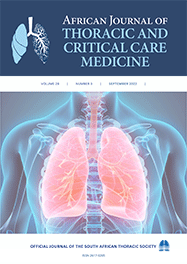Original research

Organophosphate poisoning at Chris Hani Baragwanath Academic Hospital 2012 - 2015
Abstract
Background. Patients with acute organophosphate poisoning are frequently admitted to the Chris Hani Baragwanath Academic Hospital (CHBAH), and yet there is little literature assessing aspects of these admissions.
Objectives. To determine the demographic profile, common clinical and biochemical findings, use of prognostic tools (APACHE II), management and outcome of adult patients admitted to the high care area (HCA) and intensive care unit (ICU) at CHBAH.
Methods. A retrospective data analysis of hospital records for 129 patients admitted to the HCA and ICU at CHBAH for the period 2012 - 2015 was undertaken. The demographic profiles and clinical and biochemical presentations of the patients were determined, together with their subsequent management and outcomes. Use of the APACHE II score as a prognostic tool was evaluated, and the average enzyme inhibition levels demonstrated by the patients was assessed.
Results. The median age of the group was 30 years, with 68.2% being male. The most common clinical finding was pinpoint pupils (96.1%) followed by a Glasgow Coma Score <13 (85.3%), fasciculations (60.5%), diarrhoea (37.2%) and seizures (10.1%). Admissions to the HCA (52.7%) predominated, with the majority of patients requiring ventilator support (99.2%). The mean (SD) duration of stay was 6.8 days for ICU (6.4) and 3.7 days for HCA (5.2). The overall mortality rate was 5.4%. Standard treatment was intravenous atropine. Blood results reflected low levels of acetylcholinesterase enzyme activity. The APACHE II score was underutilised.
Conclusion. The findings of the study underscore the frequent use of organophosphate compounds in our area. Further studies across the country will help to highlight the magnitude of the consequences of organophosphate poisoning, as well as the burden imposed on limited healthcare resources.
Authors' affiliations
J Bruins, Division of General Medicine, Department of Internal Medicine, Chris Hani Baragwanath Academic Hospital and Faculty of Health Sciences, University of the Witwatersrand, Johannesburg, South Africa
C Menezes, Division of Infectious Diseases, Department of Internal Medicine, Chris Hani Baragwanath Academic Hospital and Faculty of Health Sciences, University of the Witwatersrand, Johannesburg, South Africa
M Wong, Division of Pulmonology, Department of Internal Medicine, Chris Hani Baragwanath Academic Hospital and Faculty of Health Sciences, University of the Witwatersrand, Johannesburg, South Africa
Full Text:
Cite this article
Article History
Date published: 2019-09-17
Article Views
Full text views: 398
Refbacks
- There are currently no refbacks.
African Journal of Thoracic and Critical Care Medicine| Online ISSN: 2617-0205
This journal is protected by a Creative Commons Attribution - NonCommercial Works License (CC BY-NC 4.0) | Read our privacy policy.
Our Journals: South African Medical Journal | African Journal of Health Professions Education | South African Journal of Bioethics and Law | South African Journal of Child Health | Southern African Journal of Critical Care | African Journal of Thoracic and Critical Care Medicine| South African Journal of Obstetrics and Gynaecology |



.jpg)